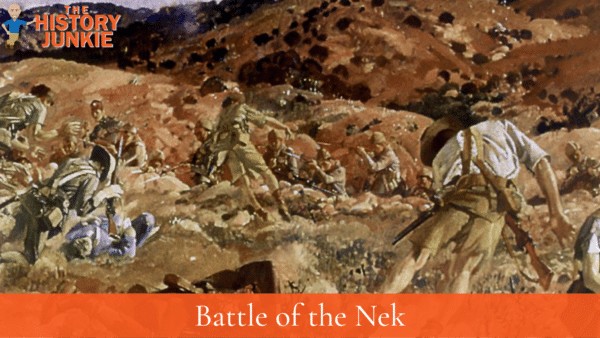The Battle of the Nek was launched on August 6, 1915, as part of a larger Allied offensive in the Gallipoli Campaign in World War 1. The offensive was led by Allied Mediterranean Commander-in-Chief Sir Ian Hamilton and included a major landing of troop reinforcements at Suvla Bay.

In addition to the landings at Suvla Bay, which aimed to secure the Anafarta Hills, the Allied forces also planned a secondary attack from Anzac Cove to seize control of the Sari Bair ridge. This attack was considered critical to the success of the overall offensive.
Prelude
The Allies planned to launch a three-pronged offensive at Gallipoli. The first prong would be a landing at Suvla Bay, the second prong would be an attack from Anzac Cove, and the third prong would be a holding attack at Helles.
The Allies believed that if they were successful at Suvla Bay and Anzac Cove, they would be able to gain control of the central heights of the peninsula. From there, they could cut off the southern peninsula and gain control of the Dardanelles Straits.
British Anzac commander William Birdwood had wanted to launch an attack on the Sari Bair ridge since May but had been prevented from doing so by Allied commander Ian Hamilton.
Hamilton believed that there were not enough Allied resources available to support the attack, particularly given the arrival of Turkish reinforcements to the sector.
However, with the promise of three fresh divisions from British war minister Lord Kitchener, Hamilton agreed to launch the attack as part of the wider Suvla Offensive.
Battle Plan
The Allies changed their plan for the attack on Gallipoli. They decided to send two Anzac brigades north along the Aegean coast from Anzac Cove. The brigades would then swing east towards the west flank and rear of Sari Bair.
Controlling the Sari Bair ridge would give the Allies a number of advantages. It would offer a panoramic view of the surrounding area, and it would prevent the Turks from using it to prevent the landings at Suvla Bay.
To support the attack on Sari Bair, the Allies added 25,000 troops to Birdwood's Australian and New Zealand Corps. This more than doubled the size of the corps to approximately 45,000.
The attack began on the morning of August 6, 1915. General Godfrey led 22,000 troops in an advance from Anzac along the Aegean coast.
However, Turkish snipers made it difficult to conduct advanced reconnaissance, and the attack was ultimately unsuccessful.
Issues for the Allies
The Allies needed to make quick progress in their advance north, but they were slowed by the maze of ridges, gullies, and heat. Dysentery also took its toll on Godfrey's men.
As a result, his force fell short of their first day's objectives, Chunuk Bair Ridge and Hill Q, by the end of the day.
Meanwhile, a heavy diversionary attack was launched from Anzac Cove south towards Lone Pine on the same evening.
The fighting continued throughout the following day, August 7, and a number of Turkish trenches fell into Allied hands on August 8.
Seven Victoria Crosses were awarded to the Anzac force for their bravery in hand-to-hand fighting at Lone Pine.
Unfortunately for the Allies, the attack on Lone Pine was not as successful as they had hoped.
The Turkish reserves that were drafted in to defend Lone Pine were then able to rush to the Sari Bair range, where they were needed more urgently.
At the same time, a supporting operation southwest of the Nek also ended in failure. The Allied forces were faced with heavy artillery and small arms fire from heavily fortified Turkish trenches.
Hamilton had previously instructed the fresh divisions that had arrived at Suvla Bay to come to Birdwood's aid in capturing Sari Bair.
However, Suvla commander Sir Frederick Stopford's policy of procrastination left Birdwood waiting in vain for support.
As a result, Birdwood decided to push onward towards Sari Bair on August 8 without Stopford's aid.
One of Birdwood's New Zealand brigades captured the crest of Chunuk Bair after the Turkish defenders withdrew. However, they were forced to abandon the position two days later under Turkish artillery bombardment.
A Gurkha battalion also attempted to capture Hill Q from the west. They were able to force the Turks off the crest of the hill but were forced to withdraw themselves after Allied naval artillery mistakenly bombarded their position.
Meanwhile, Turkish commander Mustafa Kemal (later known as Atatürk, the "Father of the Turks") sent in reinforcements. On August 10, two heavy counter-attacks were launched from the commanding height of Chunuk Bair.
As a result, the Allied Gurkha position near Hill Q at "The Farm" was effectively demolished. The New Zealanders, on the other hand, managed to hold out, but only just.
Why The Allies Failed
The Battle of the Nek depended on a rapid advance to the Sari Bair ridge. This would allow the Allied troops to consolidate their position on the ridge's summits.
However, the Allies were denied the opportunity due to a series of confused delays, a lack of command coordination, and the absence of assistance from Stopford's IX Corps at Suvla Bay.
The fighting stopped on August 10th, with both sides exhausted. Kemal's Turkish forces were the undisputed victors.
Although they suffered more casualties, with somewhere between 9,000 and 20,000 killed or wounded, Birdwood's Allied forces suffered 12,000 casualties and failed to achieve any of their objectives. The failure of the operation effectively ended Allied plans to break out of Anzac Cove.
